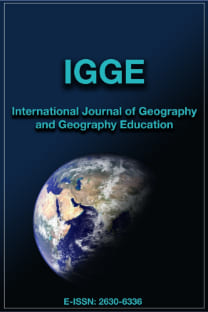BURDUR’DA DOĞA TURİZMİ İLE İLİŞKİLİ ALTERNATİF ROTALARIN BELİRLENMESİ
Doğa Turizmi, Alternatif Turizm, Turizm Rotası, Ağ Analizi, Coğrafi Bilgi Sistemleri, Burdur
DETERMINATION OF THE ALTERNATIVE ROUTES RELATED TO NATURE TOURISM IN BURDUR
Nature Tourism, Alternative Tourism, Tourism Routes, Network Analysis, Geographical Information Systems, Burdur,
___
- Boers, B. & Cottrell, S. (2007). Sustainable tourism infrastructure planning: A GIS-supported approach. Tourism Geographies, 9(1), 1-21.
- Bolton, M. (1997). Loving them and leaving them: wildlife and ecotourism. In: Bolton, M. (Eds.). Conservation and the use of wildlife resources (pp. 231-249). Dordrecht: Springer.
- Boström, M., Klintman, M. & Micheletti, M. (2008). Eco-Standards, Product Labelling And Green Consumerism, London: Springer.
- Chiu, H. Y., Chan, C. S. & Marafa, L. M. (2016). Local perception and preferences in nature tourism in Hong Kong. Tourism Management Perspectives, 20, 87-97. Bölgesi anti
- Çuhadar, M., Aydoğan, T. & Bahar, H. (2013). Web-@ ncient: Ege k kentleri için coğrafi bilgi sistemi destekli turist rota planlayıcısı tasarımı. Journal of Alanya Faculty of Business/Alanya Isletme Fakültesi Dergisi, 5(1), 31-39
- DMTP, (2013). Burdur İlinde Doğa Turizmi Master Planı T.C. Orman ve Su İşleri Bakanlığı. Burdur: Doğa Koruma ve Milli Parklar Genel Müdürlüğü, VI. Bölge Müdürlüğü, Burdur Şube Müdürlüğü.
- Güneş, G. (2008). Turizmin sürdürülebilirliği için ekoturizm. Popüler Bilim,176,28-30.
- Haberal, H. (2015). Turizmde Alternatif Ekolojik Turizm, Doğa Turizmi, Kırsal Turizm, Yayla Turizmi. Ankara: Detay Yayıncılık.
- Haberal, S. S., Looijen, J. M. & Zuidgeest, M. H. (2009). The formulation and evaluation of transport route planning alternatives: a spatial decision support system for the Via Baltica project, Poland. Journal of Transport Geography, 17(1), 54-64.
- Keshkamat, S. S., Looijen, J. M. & Zuidgeest, M. H. (2009). The formulation and evaluation of transport route planning alternatives: a spatial decision support system for the Via Baltica project, Poland. Journal of Transport Geography, 17(1), 54-64.
- Kısa-Ovalı, P. (2007). Kitle turizmi ve ekolojik turizmin kavram, mimari ve çevresel etkiler bakımından karşılaştırılması. Mimarlık Fakültesi E-Dergisi, 2(2), 64-79.
- Kiper, T. & Arslan, M. (2007). Safranbolu-Yörükköyü tarımsal turizm potansiyelinin kırsal kalkınma açısından değerlendirilmesi. Turkish Journal of Forestry, 2, 145-158.
- Köroğlu, Ö., Köroğlu, A. & Alper, B. (2012). Doğaya dayalı gerçekleştirilen turizm faaliyetleri içerisinde turist rehberlerinin rolleri üzerine bir inceleme. KMÜ Sosyal ve Ekonomik Araştırmalar Dergisi, 14(22), 131-139.
- KTB, (2007). Türkiye Turizm Stratejisi 2023 Eylem Planı 2007-2013. Ankara: T.C. Kültür ve Turizm Bakanlığı Yayınları.
- Landolo, F., Fulco, I., Bassano, C., & D’Amor, R. (2019) Managing a tourism destination as a viable complex system. The case of Arbatax Park, Landuse Policy, 84, 21-30.
- Lau, G. & McKercher, B. (2006). Understanding tourist movement patterns in a destination: A GIS approach. Tourism Hospitality Research, 7(1), 39-49.
- Luzar, E. J., Diagne, A., Gan, C. & Henning, B. R. (1995). Evaluating nature-based tourism using the new environmental paradigm. Journal of Agricultural Applied Economics, 27(2), 544-555.
- McCreary, A., Fatoric, S., Seekamp, E., Smith, J. W., Kanazawa, M. & Davenport, M. A. (2018). The ınfluences of place meanings and risk perceptions on visitors' willingness to pay for climate change adaptation planning in a nature-based tourism destination. Journal of Park Recreation Administration, 36(2), 121-140
- Mehmetoğlu, M. (2005). A case study of nature-based tourists: Specialists versus generalists. Journal of Vacation Marketing, 11(4), 357-369.
- Mowforth, M. & Munt, I. (2015). Tourism And Sustainability: Development, Globalisation And New Tourism In The Third World. London:Routledge.
- Niaraki, A. S. & Kim, K. (2009). Ontology based personalized route planning system using a multi-criteria decision making approach. Expert Systems With Applications, 36(2), 2250-2259.
- Noguera, J.M., Barranco, M.J., Segura, R.J. & MartíNez, L. (2012). A mobile 3D-GIS hybrid recommender system for tourism. Information Sciences, 215, 37-52.
- Özgüç, N. (1998). Turizm Coğrafyası (Özellikler, Bölgeler). İstanbul: Çantay Yayınları.
- Pirselimoğlu-Batman, Z. & Demirel, Ö. (2015). Ecology-based tourism potential with regard to alternative tourism activities in Altındere Valley (Trabzon–Maçka). International Journal of Sustainable Development World Ecology, 22(1), 39-49.
- Topay, M. & Parladır, M. (2015). İsparta ili örneğinde CBS yardımıyla alternatif turizm etkinlikleri için uygunluk analizi. Journal of Agricultural Sciences, 21(2), 300-309.
- Turoğlu, H. & Özdemir, H. (2005). Bartın ilinin ekotorizm potansiyelinin belirlenmesi. Doğu Coğrafya Dergisi, 10(13), 97-116.
- Wheeller, B. (2003). Alternative tourism–A deceptive ploy. In: Cooper,C. (Ed) Aspects of tourism classic reviews in tourism (pp. 227-234). Clevedon: Channel View Publications.
- Yomralioğlu, T. (2010). Geographical information technologies. J Sci Technol, 9, 49-51.
- Yayın Aralığı: Yılda 3 Sayı
- Başlangıç: 1996
- Yayıncı: Marmara Üniversitesi
RÜZGAR ENERJİSİ ÖLÇEĞİNİN TÜRKÇE GEÇERLİK VE GÜVENİRLİK ANALİZİ
Mine AYDEMİR, Nuran BAYRAM ARLI, Erhan SARI
YEREL HALKIN KIRSAL TURİZME BAKIŞ AÇISI: SAMSUN KIZILIRMAK DELTASI ÖRNEĞİ
Süleyman AKKAŞOĞLU, MURAT TELBALKAN, Ece ZEYBEK YILMAZ, Şevki ULAMA
GÖNEN ÇAYI DELTASI SULAK ALANINDA (BALIKESİR) DOĞA KORUMA: SU, KÜLTÜR VE YAŞAM
ÜSKÜDAR’DA KAPALI SİTELERİN DAĞILIŞI GELİŞİMİ VE MAHALLE YAPISINA ETKİLERİ
SOSYAL BİLGİLER ÖĞRETMEN ADAYLARININ KÜRESEL ISINMA HAKKINDAKİ ZİHİNSEL MODELLERİ
JEOMORFOLOJİ TARİHİ 1: ERKEN DÖNEM (1669’A KADAR)
INTRODUCTION OF TURKISH VOCATIONAL QUALIFICATIONS FOR GEOGRAPHICAL INFORMATION SYSTEMS RELATED JOBS
DESTİNASYON İMAJ ALGISINA YÖNELİK ÜNİVERSİTE ÖĞRENCİLERİ ÜZERİNE BİR ARAŞTIRMA: KEMALİYE ÖRNEĞİ
Muhammed TAŞ, Ceyhun AKYOL, Burhanettin ZENGİN
